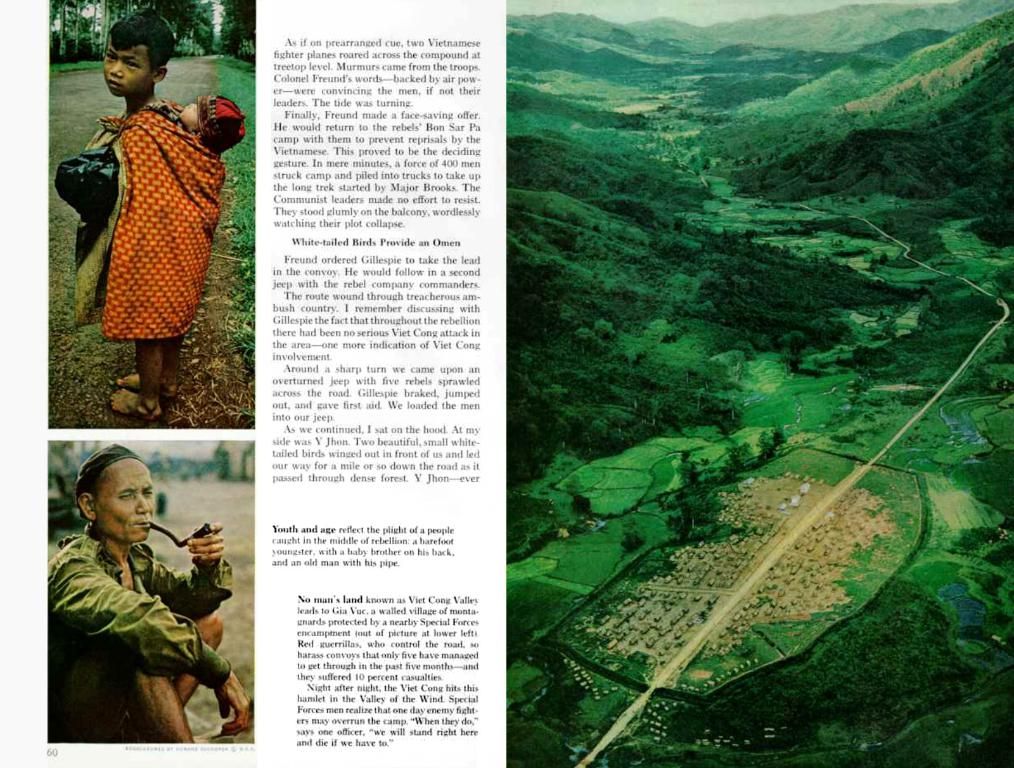Prosperous Future for Cambodia Through Renewable Energy Sources
Fresh Perspective on Cambodia's Future: Navigating the Path to High-Income Nation Status
Two years into power, Prime Minister Hun Manet faces a host of challenges. His predecessor, a steadfast leader, guided Cambodia out of genocide and ensured stability, laid the groundwork for extraordinary development, and fostered a surge in growth with an average of 7.6% annually between 1995 and 2019. Primary drivers included textiles, tourism, agriculture, and construction.
China recognized Cambodia's potential early on and has heavily invested in its infrastructure, providing funding for every hydropower dam and other civil projects. The new administration aims to build upon these foundations and achieve the Vision 2050 goal of becoming a high-income nation.
Climate change looms as a significant factor, with 2050 being a critical year for Cambodia within the framework of the Paris Climate Agreement. Its Nationally Determined Contributions require reaching net-zero Carbon Emissions with 60% of its Forest Cover by 2050. Forests act as natural carbon sinks, removing 50 Megatons of Carbon Dioxide Equivalent per year. Failure to sequester carbon in developing forests could lead to catastrophic temperature increases.
Yet, becoming a high-income nation poses challenges, particularly for those locked in the middle-income trap. To break free, a country must master the "Three Is" of development: Investment, Infusion, and Innovation. Infusion involves attracting foreign businesses and their technical expertise to transition domestic infrastructure and human capital. Post-transformation, a nation can pivot to Innovation and compete on the global stage.
Cambodia will reach $3,000 per capita in 2025, avoiding the stagnation that begins around $7-8K. However, unlocking its full potential requires foresight and decisive leadership. The future 35-year-old engineers of 2050 are currently 10-year-old students. Will they have equal opportunities to shape Cambodia's bright future? Or will they be pitted against the children of the rich?

Climate change presents both a challenge and an opportunity. Fixing the ecological crisis and lifting nations out of economic poverty requires innovation. Nuclear Power stands as the solution to a myriad of problems, offering unlimited electricity, fertilizers, fuels, clean concrete, and the potential for direct ocean carbon capture. This technology could make or break Cambodia's future energy policy.
Progress requires forward-thinking and strong leadership. Russia, China, France, Silicon Valley, and even Washington have begun embracing nuclear power and its revolutionary possibilities. Cambodia, too, must seize these opportunities and develop a strategic energy policy to thrive in the 22nd century.
Without the right strategies, Cambodia risks succumbing to the same middle-income trap that's ensnared countless other developing nations. It must invest in human capital, encourage private sector innovation, establish clear governance, and prioritize inclusive growth and economic diversification. Only by embracing the future can Cambodia reach its full potential while preserving the environment for future generations.
The clock is ticking, as rapid action is necessary to steer Cambodia away from economic and ecological collapse. This intertwined journey will demand steadfast leadership and decisive action to secure the nation's next 40-70 years of energy supply, maintain forests and waterways, and become an energy exporter that enjoys both soft and hard power.
"Reform or perish" is the Prime Minister's battle cry, and it echoes through the heart and soul of Cambodia. Hun Sen, the visionary founder, guided the nation's recovery. Now, let Hun Manet, the pragmatic innovator, lead Cambodia's economic renaissance.
- In the pursuit of achieving Vision 2050 and becoming a high-income nation, Cambodia's Prime Minister Hun Manet must address climate change, particularly focusing on carbon sequestration through forest maintenance and innovation in green technology.
- As Cambodia progresses towards the $3,000 per capita mark in 2025, its energy policy plays a crucial role in ensuring both economic growth and addressing climate change. The adoption of nuclear power, with its potential for direct ocean carbon capture, could be a pivotal decision for the country.
- In order to avoid the middle-income trap and embrace its full potential while preserving the environment for future generations, Cambodia must prioritize inclusive growth, economic diversification, and fostering private sector innovation, thereby securing its energy supply for the next 40-70 years and establishing itself as an energy exporter.







